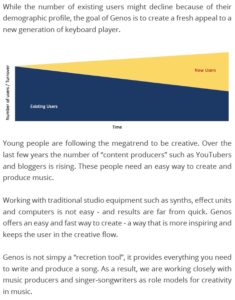The first public European demos started over the weekend. I’ve been watching Peter Baartmans and Sander Tournier put the Genos through its paces.
The whole experience has me thinking about how the Genos is being positioned in regional markets, mainly, western Europe versus North America.
First off, the arranger keyboard culture is completely different in Europe than the United States. Arranger demonstrations are big public events. One recent demo had over 500 attendees in the audience. In some venues, audience members buy tickets! This is unimaginable in the United States (except iPhone).
The European demos show off a broader range of styles. In this aspect, I’m comparing the European demos with videos made for American retailers (Guitar Center, Sweetwater, and Kraft Music). The European demos cover everything from jazz to rock to EDM to classical to traditional European pop. For the latter, think outdoor cafes and biergartens where you can spend hours with a few hundred like-minded souls. Not to mention that acquired taste, Schlager. (And that’s not a beer!)
The American demos concentrate on contemporary musical genres and styles. The Genos has new acoustic and pedal steel guitars, so Nashville and country get special emphasis. Martin Harris highlights the Kino strings coming more from a cinematic or singer-songwriter perspective. These are customers that Yamaha hopes to hook in North America. With all of its articulated sounds, the Genos is a mini-library of sampled instruments both pop and orchestral.
The American videos avoid any whiff of cheese. Unfortunately, many American listeners regard (too) many musical styles as “cheese” and the typical Guitar Center clientele are the worst offenders. Thus, you won’t hear traditional European pop in a video targeted for American retailers. In the U.S., arranger keyboards are regarded as the evil spawn of the cha-cha home organ. After playing Montage and hearing the Genos demos, a lot of folks need to adjust their thinking.
Yamaha run a risk, here, because on-line media is world-wide. I’m thinking about the videos for the Dexibell drawbar organ. A few people saw one video which didn’t fit their musical taste and bad-mouthed the Dexibell to high Heaven. They never moved on to the other videos which had some very tasty jazz.
At this point in the Genos launch, it’s a little difficult to dig out the deeper jazz, soul, R&B, and funk possibilities of the Genos. You need to wade through a lot of video to even get a sniff.
The customer base for high-end arranger keyboards is aging. Even the European audiences have a lot of “gray heads.” (I’m getting grayer by the day, too. 🙂 ) Yamaha and its dealers want to entice a younger crowd with arranger keyboards. But, they have a dilemma. A young person today does not have the disposable income for a $5,500 (USD street) keyboard, especially when they can make music with their smart phone, tablet or laptop. The entry price to EDM, for example, is much lower than the price of a Genos.

[Source: Yamaha Easy Product Guide, 2017; Click to enlarge.]
Yamaha led the Genos campaign with EDM. This gave the Genos a youthful cachet, but alienated many people in the historical customer base for high-end arranger product. Folks wondered, “Did they drop the big band styles?” However, let’s say that Yamaha did put a schmaltzy big band tune into the Guitar Center video. Instant turn off. Personally, I wouldn’t mind a big band tune. I grew up listening to Glenn Miller and Benny Goodman, but that was my father’s music. (BTW, I respect that music; I just don’t play it.) Most people can’t look beyond the end of their own musical nose.
So, where do Yamaha find customers with sufficient disposable income and maybe the time and interest? Back to the 80s! The Genos has some excellent styles that allow note-for-note covers of famous 1980s pop and rock, including synth-heavy 80s pop. We all tend to relate emotionally to the music of our teen years and early 20s. Let’s take 1985 as the midpoint, subtract 20 years and look to people born around 1965 or so. They were teens when 80s music was happening. Thus, Yamaha are targeting people in their late 40s and early 50s — old enough to have the disposable income for a high-end arranger while young enough to rebuild the aging customer base.
Well, I hope this ramble has given you a different perspective on Genos and arranger keyboard marketing. The Yamaha demos are carefully designed and scripted to appeal to target market segments. Where do you fit?
Copyright © 2017 Paul J. Drongowski
